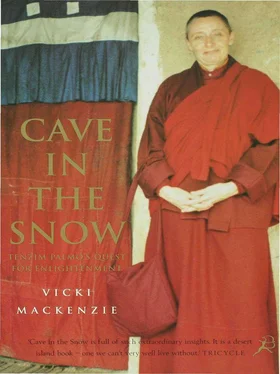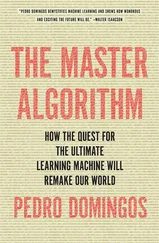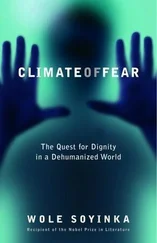‘I laughed and laughed. The nun who’d delivered the post asked what was going on. “Three men think I should marry them,” I told her. She asked me which one was I going to accept. I paused for a moment and replied, “I’m not going to marry any of them. I’m going to be a nun.” None of those men realized I was having the time of my life. They all thought that because I wasn’t with them I must be miserable. They didn’t understand at all. At that moment I remembered again what I was there for.’
The fact was that some truly remarkable and interesting new men were coming into Tenzin Palmo’s life. The English author John Blofeld, well known for his rendering of the Zen masters and his translation of the I Ching , climbed the hill to visit her. She had written to him after reading The Wheel of Life , the account of his own journey into Buddhism written with exquisite eloquence, expressing how much the book had meant to her, and much to her surprise he had replied. A long correspondence followed in which Tenzin Palmo spoke of her plans and John Blofeld had replied offering guidance and advice. He was to play an important part in her life right up to his death in 1987.
‘He was much older than me but we got along splendidly.
He was a lovely friend and such a wonderful person – kind, intelligent. He was a very humble person who had a genuine devotion to the dharma (Buddhist path) without any kind of arrogance at all. Towards the end he wrote to me saying he was becoming more and more involved in Chinese Buddhism, was beginning to talk Mandarin like a Chinese, had grown a white beard, and that when he looked in the mirror he reminded himself of a Taoist sage. I replied that I’d hoped he’d grown his hair too and was wearing it in a top knot with a jade clip because if you’re going to do something it’s worth doing properly,’ she said, quoting her own personal lore. ‘With him it was all very natural – like rediscovering a personality that was very deep.
‘But he also had a very strong connection with the Tibetans, especially with Tara. He loathed, however, what they were giving us to eat; dumplings one day, rice and lentils the next. Personally, I couldn’t see what was wrong with it!’ she added.
Being one of the first Westerners on the scene, Tenzin Palmo once again found herself in the unique position of meeting some of the most eminent lamas in Tibetan Buddhism, figures such as H.H. the Karmapa, head of the Kargyu lineage, whose reincarnations can be traced back back further than the Dalai Lama’s. He was held in immense reverence by all Tibetans.
‘It was a wonderful period. At that time if you were a Westerner who was interested in the dharma everyone was amazed and delighted and all the doors were open,’ she recalled.
‘I remember the first time I met the Karmapa, I was very afraid as he looked so severe, rather like Napoleon. I went in and started prostrating and heard this very high-pitched giggle. I looked up and there he was with his big dimples giggling, pointing a finger saying, “Who’s this, who’s this?” At that time we really got the red carpet treatment, not like nowadays.’
One day in June, just three months after she had arrived in Dalhousie, she met the Dalai Lama himself. She was wearing traditional Tibetan costume – a floor-length wrap-around dress, called a chuba, in dark blue with an underblouse of turquoise, which had formerly belonged to a princess. It was warm and elegant. ‘You look like a lady from Lhasa,’ were the Dalai Lama’s opening words. These were followed by the far more enigmatic phrase: ‘Oh, Ani-la, tukdam gong phel?’ (‘Oh, nun, is your practice progressing well?’)
The interpreter turned to Tenzin Palmo in confusion. ‘I don’t know why he called you Ani-la, and that greeting is only used when two hermits meet,’ he said. Had the Dalai Lama with his legendary clear-sightedness seen what was to come and maybe even what had gone before?
Tenzin Palmo looked at the Dalai Lama and heard herself saying: ‘No, I’m not from Lhasa, I’m a Khampa,’ meaning a person who originates from Kham, a region in eastern Tibet. She had no idea why she said it – having no particular knowledge of Kham or Khampas either.
‘What are your plans?’ inquired the Dalai Lama next.
‘You should know that the best of all plans go astray,’ replied Tenzin Palmo, with a boldness that was to surface on a much later date when she was to address the Dalai Lama again on a much more serious issue.
A week after this auspicious encounter Tenzin Palmo was to meet the most important man in her life – the man she had gone to India to find.
The eighth Khamtrul Rinpoche had come a long way.
He had left his monastery in Kham, East Tibet, one night, disguised as a merchant ready to make his daring escape. The Khampagar was a vast edifice as big as a palace, with bright yellow walls and a golden roof that glittered in the pristine Tibetan sun. It had been his world for almost thirty years, if you counted just this lifetime. If you took in all of his reincarnations, however, it had been his home, and the seat of his considerable power for the past 450 years ever since 1548, when the first of his reincarnations had been recognized. By the time the eighth Khamtrul Rinpoche was born, some time in the 1930s, the Khampagar had grown in size and influence, to encompass some 200 daughter monasteries, hundreds of thousands of monks, and an elite corps of yogis famed throughout all Tibet. This wasn’t all. Like some enclave of Eastern Renaissance, over the centuries the Khampagar had simultaneously developed excellence in all fields of sacred art including painting and Lama dancing. In the face of the Chinese destruction, Khamtrul Rinpoche was leaving it all behind – the pomp, the privilege, the regalia, his retinue and an entire way of life.
The journey out had been treacherous. Travelling by horse with a small band of followers, they had crossed icy rivers in full flood, the horses swimming with just their nostrils above water, their meagre possessions transported on rafts. It was said that Khamtrul Rinpoche had calmed the waves by throwing sacred sand on them, but, whatever the reason, no life was lost and all their goods made it safely to the other side. After that there was a wide stretch of open land to traverse in full view of a road used by convoys of Chinese military trucks. Miraculously not one came into sight as the horseman rode on. The last and greatest obstacle was the Himalayas themselves, the highest mountain ranges in the world. Khamtrul Rinpoche had ridden over them and down into the safety of India.
For the past couple of years he had been in and around Dalhousie with the rest of the Tibetans, gathering together the few of his disciples who had also managed to escape, trying to resurrect the Khampagar way of life on this very foreign soil. On 30 June 1964 Khamtrul Rinpoche found himself at the Young Lamas’ Home School visiting Freda Bedi.
Tenzin Palmo had her first premonition that her guru was about to appear one evening as she was checking the school’s correspondence. In among all the letters she found one from a Tibetan craft community, enclosing a sample of hand-made paper which they hoped Mrs Bedi could market. It was signed by someone called Khamtrul Rinpoche. She had no idea who Khamtrul Rinpoche was, but as she later put it, ‘The second I read that name faith arose.’
She turned to Mrs Bedi, heard his story and learnt that he was expected any day. ‘The more I heard about him the more excited I became. I felt this was the person I wanted to take Refuge with,’Tenzin Palmo explained, referring to the ceremony where one commits officially to the Buddhist path.
Читать дальше












